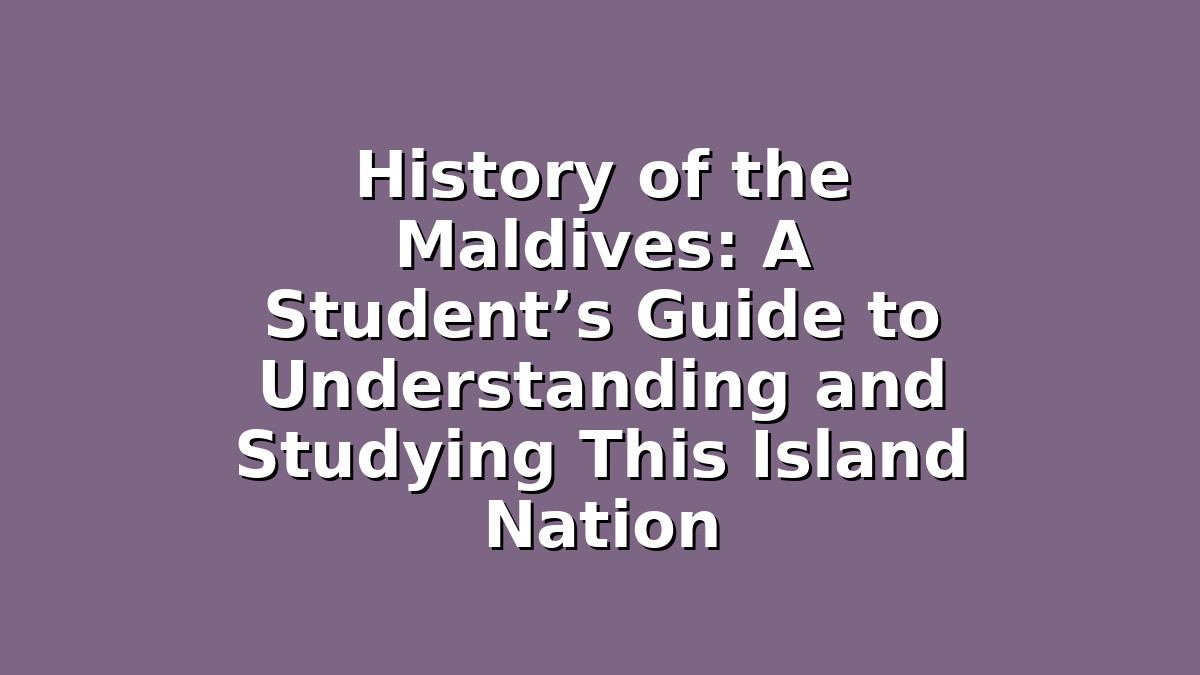The Maldives, a stunning archipelago located in the Indian Ocean, is famous for its crystal-clear waters, vibrant coral reefs, and luxurious resorts. But beyond its natural beauty lies a rich and fascinating history that reveals the cultural and political evolution of this island nation. For students preparing for exams or those interested in broadening their knowledge, understanding the history of the Maldives can be both rewarding and insightful. This article will provide a detailed overview of the Maldives’ history while offering practical study tips to help you learn more effectively and excel in your exams.
Introduction to the Maldives’ History
The Maldives has a unique historical journey shaped by its geographic location and interactions with various cultures. From early settlement and Buddhist influences to Islamic conversion and colonial encounters, the Maldives’ history is a vivid tapestry of change and resilience. For students, mastering this subject can seem challenging due to the volume of information and dates involved. However, with the right study strategies, you can grasp the key events and their significance confidently.
—
1. Early History and Cultural Foundations: Study Tip – Create Timelines for Context
The earliest known settlers of the Maldives are believed to have arrived around 500 BCE, likely from the Indian subcontinent and Sri Lanka. Archaeological evidence suggests that the islands were initially influenced by South Asian cultures, including Buddhism, which was the dominant religion before the arrival of Islam.
Key Historical Points:
– The Maldives was initially populated by Dravidian peoples.
– Buddhism flourished for centuries, leaving behind ancient stupas and artifacts.
– The islands were part of the larger Indian Ocean trade network, connecting them to traders from Arabia, Persia, and East Africa.
Study Advice:
Creating timelines is an effective way to organize historical events chronologically. For the Maldives, start by mapping out early settlements, major cultural shifts, and trade connections. This visual aid helps students see the progression and overlapping influences over time, making it easier to remember key developments. For example, place the arrival of Buddhism around 300 BCE and mark the transition to Islam in 1153 CE on your timeline to clarify the sequence of religious changes.
—
2. The Islamic Period and Sultanate Era: Study Tip – Use Mind Maps to Connect Themes
One of the most significant turning points in Maldivian history was the conversion to Islam in 1153 CE. According to legend, a visiting Muslim scholar converted the local king, leading to the establishment of the Islamic Sultanate, which shaped the country’s identity for centuries.
Key Historical Points:
– The Maldives became a sultanate, ruled by Muslim monarchs.
– Islam influenced not only religion but also legal, social, and political systems.
– The islands maintained independence despite pressures from colonial powers.
– Famous sultans like Sultan Muhammad Thakurufaanu resisted Portuguese invasions in the 16th century, preserving Maldivian sovereignty.
Study Advice:
Mind maps are excellent tools for understanding how different historical themes interlink. Center your mind map on the Islamic period and branch out to topics such as religion, governance, foreign relations, and resistance movements. This approach helps you see how Islam shaped multiple facets of Maldivian society, making it easier to write essays or answer exam questions that require analysis of cause and effect.
—
3. Colonial Era and Modern Independence: Study Tip – Practice Past Exam Questions
Though the Maldives avoided full colonial domination, it was influenced by Portuguese, Dutch, and British powers. The British established a protectorate over the Maldives in 1887, which lasted until the country gained full independence in 1965. This period also saw modernization efforts and the eventual establishment of a republic in 1968.
Key Historical Points:
– Portuguese occupation attempts in the 16th century were resisted successfully.
– The Maldives became a British protectorate, maintaining internal autonomy but relying on Britain for defense and foreign affairs.
– Independence was achieved peacefully in 1965, followed by political reforms.
– The first president of the Maldives was Ibrahim Nasir, who played a crucial role in modernization.
Study Advice:
One of the best ways to prepare for exams is by practicing past questions related to the Maldives’ colonial and post-colonial history. This helps you familiarize yourself with the types of questions educators ask — whether they focus on dates, causes of independence, or significant leaders. Additionally, writing out answers under timed conditions improves your ability to recall information and articulate your knowledge clearly.
—
Conclusion: Mastering the History of the Maldives with Confidence
Studying the history of the Maldives offers students a glimpse into a fascinating island nation’s cultural and political journey. By breaking down the historical timeline, connecting themes with mind maps, and practicing exam questions, students can build a strong understanding that will serve them well in their exams and beyond. Remember, history is not just about memorizing facts but about understanding the stories and forces that have shaped a nation. Stay curious, organize your study materials efficiently, and approach your exam preparation with confidence—you’ve got this!
—

Responses